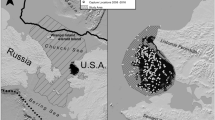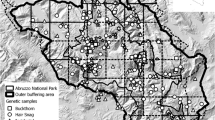Abstract
We estimated demographic parameters and current harvest risks for a population of polar bears (Ursus maritimus Phipps) inhabiting northern Smith Sound and Kane Basin, Canada and Greenland. Our demographic analysis included a detailed assessment of age- and sex-specific survival and recruitment from 141 marked polar bears, using information contained within the standing age distribution of captures and mark-recapture analysis. Total survival rates \( (\ifmmode\expandafter\bar\else\expandafter\=\fi{x} \pm 1\;{\text{SE}}) \) for females were: 0.374 ± 0.180 (cubs), 0.686 ± 0.157 (ages 1–4), and 0.967 ± 0.043 (ages 5+). Mean litter size was 1.67 ± 0.08 cubs. Females did not reproduce until at least age 6, which is late compared to other populations of polar bears. The model-averaged, mark–recapture estimate of mean abundance (±1 SE) for years 1994–1997 was 164 ± 35 bears. We incorporated demographic parameters and their variances into a harvest risk analysis (i.e., a stochastic, harvested population viability analysis, PVA). Results suggest that polar bears in the region were severely over-harvested during the mark–recapture interval (1992–1997). The current status of the population is unknown.


Similar content being viewed by others
References
Aars J, Lunn NJ, Derocher AE (eds) (2006) Polar bears: proceedings of the 14th working meeting of the IUCN/SSC Polar Bear Specialist Group, 20–24 June 2005, Seattle, Washington, USA. IUCN, Gland, Switzerland and Cambridge, UK, 198 pp
Allee WC (1931) Animal aggregations: a study in general sociology. University of Chicago Press, Chicago
Amstrup SC (2003) Polar bear. In: Feldhamer GA, Thompson BC, Chapman JA (eds) Wild mammals of North America: biology, management, and conservation. John Hopkins University Press, Baltimore, pp 587–610
Arveson JN (1969) Jackknifing U-statistics. Ann Math Stat 40:2076–2100
Born EW, Teilmann J, Acquarone M, Riget FF (2004) Habitat use of ringed seals (Phoca hispida) in the North Water area (North Baffin Bay). Arctic 57:129–142
Born EW (2005) The catch of polar bears in Greenland, 1993–2004. Report to the Canadian Polar Bear Technical Committee’s meeting, Edmonton, Canada. Greenland Institute of Natural Resources, Nuuk, Greenland, 10 pp
Burnham KP (1993) A theory for combined analysis of ring recovery and recapture data. In: Lebreton JD, North PM (eds). Marked individuals in the study of bird populations. Birkhäuser, Basel, pp 199–213
Burnham KP, Anderson DR (2002) Model selection and multimodel inference: a practical information–theoretic approach. Springer, New York
Calvert W, Ramsay MA (1998) Evaluation of age determination of polar bears by counts of cementum growth layer groups. Ursus 10:449–453
Caughley G (1977) Analysis of vertebrate populations. Wiley, New York
CCAC (1984) Wild vertebrates in the field and in the laboratory. In: Gilman J (ed) Guide to the care and use of experimental animals, vol. 2. Canadian Council on Animal Care, Ottawa, pp 381–401
Clark JD, Eastridge R (2006) Growth and sustainability of black bears at White River National Wildlife Refuge, Arkansas. J Wildl Manage 70:1094–1101
Cohen D (1970) The optimal timing of reproduction. Am Nat 110:801–807
Comiso JC, Parkinson CL (2004) Satellite-observed changes in the Arctic. Phys Today 57:38–44
COSEWIC (2002) COSEWIC assessment and update status report on the polar bear Ursus maritimus in Canada. Committee on the Status of Endangered Wildlife in Canada, Ottawa
Derocher AE, Stirling I (1995) Mark-recapture estimation of population size and survival rates for polar bears in western Hudson Bay. J Wildl Manage 59:215–221
Derocher AE, Lunn NJ, Stirling I (2004) Polar bears in a warming climate. Integr Comp Biol 44:163–176
Dobey S, Masters DB, Scheick BK, Clark JD, Pelton MR, Sunquist ME (2005) Ecology of Florida black bears in the Okefenokee-Osceola ecosystem. Wildl Monogr 158
Ferguson SH, McLoughlin PD (2000) Effect of energy availability, seasonality, geographic range on brown bear life history. Ecography 23:193–200
Garshelis DL, Noyce KV, Coy PL (1998) Calculating average age of first reproduction free of the biases prevalent in bear studies. Ursus 10:437–447
Hassol SJ (2004) Impacts of a warming Arctic: Arctic climate impact assessment. Cambridge University Press, Cambridge
Howe EJ, Obbard ME, Schaefer JA (2007) Extirpation risk of an isolated carnivore population under different management scenarios. J Wildl Manage 71 (in press)
Lebreton JD, Burnham KP, Clobert J, Anderson DR (1992) Modeling survival and testing biological hypotheses using marked animals: a unified approach with case studies. Ecol Monogr 62:67–118
McCullagh P, Nelder JA (1991) Generalized linear models. Chapman and Hall, London
Manly BFJ (1997) Randomization, bootstrap and Monte Carlo methods in biology. Chapman and Hall, London
McDonald TL, Amstrup SC (2001) Estimation of population size using open mark–recapture models. J Agri Biol Env Stat 6:206–220
Paetkau D, Amstrup SC, Born EW, Calvert W, Derocher AE, Garner GW, Messier F, Stirling I, Taylor MK, Wiig Ø, Strobeck C (1999) Genetic structure of the world’s polar bear populations. Mol Ecol 8:1571–1584
PBTC (2007) Minutes of the 2007 Polar Bear Technical Committee Meeting, Edmonton, Alberta, February 2007. Canadian Wildlife Service, Edmonton. 31 pp
Philippi T, Seger J (1989) Hedging one’s evolutionary bets, revisited. TREE 4:41–44
Rosing-Asvid A (2002) The polar bear hunt in Greenland. Technical report No. 45. Greenland Institute of Natural Resources, Nuuk, 25 pp
Rosing-Asvid A, Born EW (1990) Fangst af isbjørn (Ursus maritimus) i Avanersuaq og Upernavik kommuner:en interviewundersøgelse. Teknisk rapport 23, Grønlands Hjemmestyre, Miljø-og Naturforvaltning. 64 pp (with English summary)
Sajah H, Perrin N (1990) Autumnal vs. spring hatching in the fairy shrimp Siphonophanes grubii (Dybowski)(Crustacea, Anostraca): diversified bet-hedging strategy?. Func Ecol 4:769–775
Seber GAF (1982) The estimation of animal abundance and related parameters. Macmillan, New York
Stirling I, Spencer C, Andriashek D (1989) Immobilization of polar bears (Ursus maritimus) with Telazol in the Canadian Arctic. J Wildl Dis 25:159–168
Stirling I, Parkinson CL (2006) Possible effects of climate warming on selected populations of polar bears (Ursus maritimus) in the Canadian Arctic. Arctic 59:261–275
Taylor MK, Bunnell F, DeMaster D, Schweinsburg R, Smith J (1987a) ANURSUS: a population analysis system for polar bears (Ursus maritimus). Int Conf Bear Res Manage 7:117–125
Taylor MK, Carley JS, Bunnell FL (1987b) Correct and incorrect use of recruitment rates for marine mammals. Mar Mam Sci 3:171–178
Taylor MK, Kuc M, Abraham D (2000) Vital rates: population parameter analysis program for species with three year reproductive schedules. Government of Nunavut, Iqaluit
Taylor MK, Akeeagok S, Andriashek D, Barbour W, Born EW, Calvert W, Ferguson S, Laake J, Rosing-Asvid A, Stirling I, Messier F (2001) Delineating Canadian and Greenland polar bear (Ursus maritimus) populations by cluster analysis of movements. Can J Zool 79:690–709
Taylor MK, Laake J, Cluff HD, Ramsay M, Messier F (2002) Managing the risk from hunting for the Viscount-Melville Sound polar bear population. Ursus 13:185–202
Taylor MK, Obbard M, Pond B, Kuk M, Abraham D (2003) A guide to using RISKMAN: Stochastic and deterministic population modeling RISK MANagement decision tool for harvested and unharvested populations. Version 1.9. Ont Min Nat Res, Peterborough http://www.nrdpfc.ca/riskman/riskman.htm
Taylor MK, Laake J, McLoughlin PD, Born EW, Cluff HD, Ferguson SH, Rosing-Asvid A, Schweinsburg R, Messier F (2005) Demography and viability of a hunted population of polar bears. Arctic 58:203–215
Taylor MK, Laake JL, McLoughlin PD, Cluff HD, Messier F (2006) Demographic parameters and harvest-explicit population viability analysis for polar bears in M’Clintock Channel, Nunavut. J Wildl Manage 70:1667–1673
Wear BJ, Eastridge R, Clark JD (2005) Factors affecting settling, survival, and viability of black bears reintroduced to Felsenthal National Wildlife ReFuge, Arkansas, Wildl Soc Bull 33:1363–1374
White GC, Burnham KP (1999) Program MARK: survival estimation from populations of marked animals. Bird Study Suppl 46:120–138
Wielgus RB (2002) Minimum viable population and reserve sizes for naturally regulated grizzly bears in British Columbia. Biol Cons 106:381–388
Wiig Ø (2005) Are polar bears threatened?. Science 309:1814–1815
Yoshimura J, Jansen VAA (1996) Evolution and population dynamics in stochastic environments. Res Pop Ecol 38:165–182
Acknowledgments
This work was funded by the Government of Nunavut, the Greenland Institute of Natural Resources, the Polar Continental Shelf Project, the University of Saskatchewan, and the U.S. National Marine Mammal Laboratory. Hunters and trappers of Grise Fiord contributed their knowledge of polar bears in the Kane Basin area. M. Kuc was the primary programmer for RISKMAN and contributed to the development of its algorithms.
Author information
Authors and Affiliations
Corresponding author
Rights and permissions
About this article
Cite this article
Taylor, M.K., Laake, J., McLoughlin, P.D. et al. Population parameters and harvest risks for polar bears (Ursus maritimus) of Kane Basin, Canada and Greenland. Polar Biol 31, 491–499 (2008). https://doi.org/10.1007/s00300-007-0375-y
Received:
Revised:
Accepted:
Published:
Issue Date:
DOI: https://doi.org/10.1007/s00300-007-0375-y




